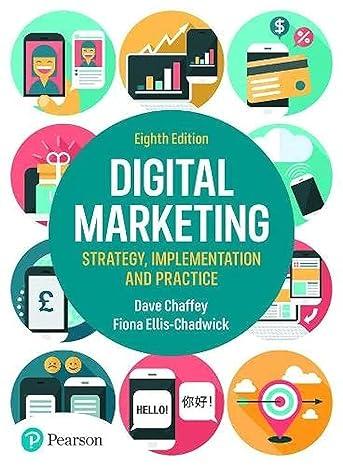This case study explores the strategy and management adopted by LOral Group when deploying digital technologies to
Question:
This case study explores the strategy and management adopted by L’Oréal Group when deploying digital technologies to advance market share to build a Digital First company and achieve digital transformation for the group.
The L’Oréal Group consists of four divisions: Consumer Products, Professional Products, Active Cosmetics and L’Oréal Luxe. Each division serves different and distinct markets, with highly recognisable brands including Maybelline, L’Oréal Paris, Lancôme, Vichy, Matrix and Helena Rubenstein. Each division has utilised various digital technologies and channels to achieve corporate goals through this transformative period. All divisions have embraced digital to leverage competitive advantage and create value for their target customers.
L’Oréal’s product ranges are extensive: skincare, cosmetics, makeup, haircare and fragrances, and as a result the company can tailor products to meet the needs of almost every customer who is in the market for beauty products around the world.
Company Purpose and Mission
L’Oréal Group operates in the beauty sector and its corporate goals seek to provide everyone with the opportunity to access excellent-quality beauty products, which are produced safely and responsibly. This goal statement gives the group the opportunity to focus its strategy and management on the business of product innovation and delivering customer value while adhering to exacting ethical principles and valuing diversity. Digital is now playing a very important part.
Strategic Digital Transformation
This organisation has had a long tradition of responding to the external macro-environment since its foundation in 1909, so it is no surprise that the senior management team has closely monitored the rising significance of digital technologies, given the implications for research and development, product innovation, communications and consumer behaviour. This global company’s history of innovation has enabled it to become the largest beauty company in the world, with over 500 brands.
Internally, the micro-environment is also very focused, active and lively. Since 2006, when Jean-Paul Agon joined as CEO, the group has doubled its revenue to €30 billion. By fostering an organisational culture that is said to be demanding, managers are expected to be dynamic and ‘should cultivate saine inquietude, or “healthy disquiet”, among their teams, so as to see who rises to the occasion – and who sinks’ (Abboud, 2020). Mr Agon refers to employees as a tribe, and this means sharing customs, codes and values, which enables the culture of the organisation to transcend international borders and fosters internal collaboration and communication. When it comes to digital transformation, fast pace of change was seen as a matter of survival. So, demands on the management team responsible for the digital transformation were significant. One such senior manager who has succeeded is Lubomira Rochet, who joined L’Oréal in 2015 as Chief Digital Officer, and she accepted a challenging brief: to revolutionise the organisation’s approach to digital and to create ‘social and digital powerhouses’.
Furthermore, the L’Oréal Group took a strategic focus when looking at how it could adapt the business to operate effectively as the world moved into the digital economy, adopting the phrase ‘Digital First company’.
This meant enabling digital to touch every part of the business. The impetus to change the business and adopt a technology-driven orientation was in order to reflect the changing world and the ways in which consumption was undergoing a quiet revolution.......
Questions
1 Discuss how digital tools and technology are driving the development of the L’Oréal Group.
2 Mass personalisation has the potential to add value for customers. Explain how each of L’Oréal’s divisions benefits from this focus on the individual customer.
3 Consider the extent to which the macro- and micro-environment influences have shaped L’Oréal’s Digital First strategy.
4 Choose one of the L’Oréal divisions and find out more about how it is currently utilising digital technologies and tools to meet the company’s corporate goals.
Step by Step Answer:

Digital Marketing Strategy Implementation And Practice
ISBN: 247145
8th Edition
Authors: Dave Chaffey, Fiona Ellis Chadwick





